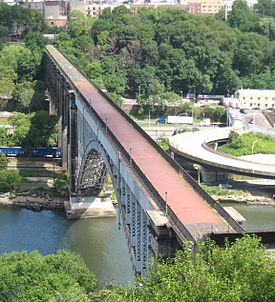High Bridge (New York City)
| High Bridge | |
|---|---|

from Highbridge Park (2008)
|
|
| Crosses | Harlem River |
| Locale | Manhattan and the Bronx, in New York City |
| Maintained by | New York City Department of Parks and Recreation |
| Characteristics | |
| Design | Arch bridge |
| Total length | 1,450 ft (440 m) |
| Clearance below | 140 ft (43 m) |
| History | |
| Opened | 1848 (original aqueduct) 1927 (partly rebuilt) 2015 (reopened as walkway) |
| Closed | 1970s |
Coordinates: 40°50′32″N 73°55′49″W / 40.842308°N 73.930277°W
The High Bridge (originally the Aqueduct Bridge) is the oldest bridge in New York City, having originally opened as part of the Croton Aqueduct in 1848 and reopened as a pedestrian walkway in 2015 after being closed for over 40 years. A steel arch bridge with a height of 140 ft (43 m) over the Harlem River, it connects the New York City boroughs of the Bronx and Manhattan. The eastern end is located in the Highbridge section of the Bronx near the western end of West 170th Street, and the western end is located in Highbridge Park in Manhattan, roughly parallel to the end of West 174th Street.
Although the bridge was originally completed in 1848 as a stone arch bridge, the Harlem River span was replaced with a steel arch during a 1927 renovation. The bridge was closed to all traffic from the 1970s until its restoration, which began in 2009. The bridge was reopened to pedestrians and bicycles on June 9, 2015.
The bridge is operated and maintained by the New York City Department of Parks and Recreation.
Originally designed as a stone arch bridge, the High Bridge had the appearance of a Roman aqueduct. Construction on the bridge was started in 1837, and was completed in 1848 as part of the Croton Aqueduct, which carried water from the Croton River to supply the then burgeoning city of New York some 10 miles (16 km) to the south. The bridge has a height of 140 ft (43 m) above the river 620-foot (190 m)-wide Harlem River, with a total length of 1,450 ft (440 m). The design of the bridge was originally awarded to Major David Bates Douglass, who was fired from the project. The design then fell to the aqueduct's engineering team, led by John B. Jervis. James Renwick, Jr., who later went on to design the landmark Saint Patrick's Cathedral on Fifth Avenue in Midtown Manhattan, participated in the design.
...
Wikipedia
